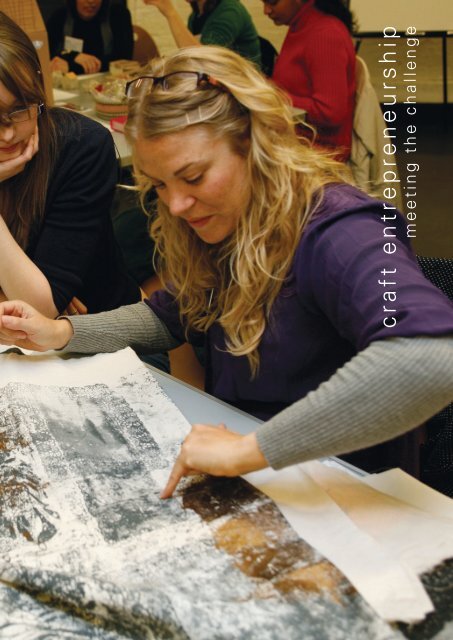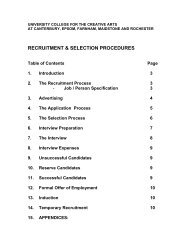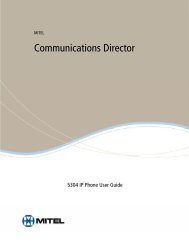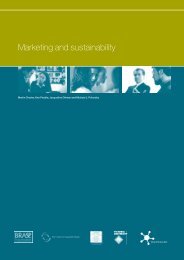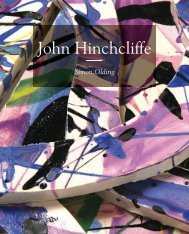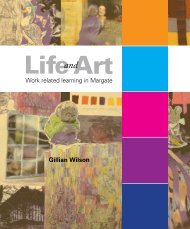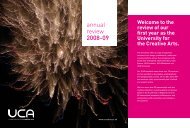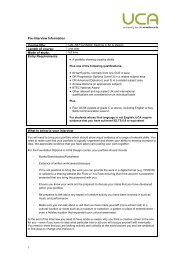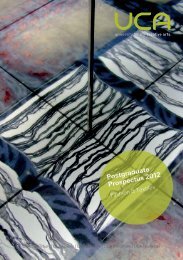Craft Entrepreneurship - University for the Creative Arts
Craft Entrepreneurship - University for the Creative Arts
Craft Entrepreneurship - University for the Creative Arts
You also want an ePaper? Increase the reach of your titles
YUMPU automatically turns print PDFs into web optimized ePapers that Google loves.
c r a f t e n t r e p r e n e u r s h i pm e e t i n g t h e c h a l l e n g e
<strong>for</strong>ewordThe current interest in creative entrepreneurship stems from a variety ofimpulses: one is <strong>the</strong> recognition of <strong>the</strong> potential of <strong>the</strong> creative industriesto stimulate <strong>the</strong> economy alongside an understanding that creativeenterprises have developed very particular business models. Variousthough <strong>the</strong>se may be, creative enterprises are often small lifestylebusinesses motivated as much by opportunities <strong>for</strong> self-reflectivepractice as <strong>the</strong>y are by commercial success. Crude definitions of <strong>the</strong>entrepreneur simply do not work <strong>for</strong> <strong>the</strong>se industries and can be offputtingto students (Creating <strong>Entrepreneurship</strong>, ADM and NESTA, 2007).<strong>Craft</strong> <strong>Entrepreneurship</strong> was stimulated by our conviction of <strong>the</strong> specialcontribution of contemporary crafts to <strong>the</strong> creative industries, alongside<strong>the</strong> very real difficulties craft practitioners face in finding new and largeenough markets to support <strong>the</strong>ir work (Making it to Market, ACE, 2006).With <strong>the</strong> support of <strong>the</strong> <strong>University</strong> College <strong>for</strong> <strong>the</strong> <strong>Creative</strong> <strong>Arts</strong> and<strong>the</strong> Higher Education <strong>Entrepreneurship</strong> Group we set about creatingone of those ‘what if’ moments, unconstrained by curriculum designand anxieties over whe<strong>the</strong>r entrepreneurship can be taught. Ten craftstudents were each teamed with a business and brand design studentdrawn from 10 Higher Education Institutions across <strong>the</strong> South Eastregion. In addition to <strong>the</strong> student teams we added <strong>the</strong> expertise of PRconsultant Lynne Franks, business finance specialist Ray Wright andleading craft entrepreneur Mark Bickers to create a learning laboratorywith surprisingly modest expectations. Would students gain valuein working collaboratively; would <strong>the</strong>y be prepared to take risks andto venture and abandon <strong>the</strong>ir ideals? Would <strong>the</strong> tensions betweencommercialisation and artistic identity prove to be compromising?Could we foster <strong>the</strong> kind of divergent thinking processes that mighttrans<strong>for</strong>m <strong>the</strong> very basis of <strong>the</strong> students’ practice and <strong>the</strong>ir potential asan entrepreneur?Through <strong>the</strong> case studies of <strong>the</strong> student teams presented here I hopewe manage to capture something of <strong>the</strong> extraordinariness of <strong>the</strong> <strong>Craft</strong><strong>Entrepreneurship</strong> Workshop: a set of courageous business models<strong>for</strong> craft enterprises at <strong>the</strong> heart of which was <strong>the</strong> clearly visibleand uncompromised self-identity of <strong>the</strong> student practitioner. Equallysignificant was <strong>the</strong> perceived value of working in multi-disciplinary teamsproviding a ‘client’ experience <strong>for</strong> business and branding students andaccess to expert knowledge <strong>for</strong> craft students.Despite <strong>the</strong> apparent success of <strong>the</strong> event in gaining some inkling ofwhat worked <strong>for</strong> students of contemporary craft, I am also consciousof <strong>the</strong> small impact of this style of ‘learning event’ and <strong>the</strong> need tocreate curriculum models <strong>for</strong> entrepreneurship that retain <strong>the</strong> right levelof energy and intensity, and at <strong>the</strong> same time offer sustainability - infunding terms, but perhaps more problematically, in HEI and multidisciplinary<strong>for</strong>ms of learning collaboration.Dr Roni BrownDeputy Head of College (Quality and External Development)<strong>University</strong> College <strong>for</strong> <strong>the</strong> <strong>Creative</strong> <strong>Arts</strong>, FarnhamDr Roni Brown
preface:crafting a businessSetting up your own business after you leave creative education can be a daunting experience. Notonly do you have to continue <strong>the</strong> creative side of your practice but you soon face new, unfamiliarchallenges such as tackling sales, marketing and office administration. My introduction to <strong>the</strong>seactivities on my degree course amounted to a brief explanation of conventional ways of marketingand selling your work. This tended to lead students towards following well-established methodsof operating as a designer maker. Obviously learning practical business principles such as writing abusiness plan and book keeping has its place and needs to be learned, however I think it is imperativethat during a creative education you are exposed to <strong>the</strong> idea that <strong>the</strong> ‘business’ aspects of youractivity can be developed just as creatively as your practice. With a small shift in thinking it is possibleto see <strong>the</strong> business side in <strong>the</strong> same way as a design problem; one that can be creatively thoughtabout, brainstormed, challenged and resolved in surprising and unconventional ways. If makers wereencouraged to consider using <strong>the</strong>ir creative thinking skills to tackle <strong>the</strong> business and commercialpossibilities of <strong>the</strong>ir work earlier in <strong>the</strong>ir careers, <strong>the</strong>y would be better placed to create inventivebusiness models that <strong>the</strong>y can truly own and find rewarding.Glass designer Mark BickersThe <strong>Craft</strong> <strong>Entrepreneurship</strong> Workshop addressed <strong>the</strong>se issues by combining craft, branding andmarketing students. They were challenged to think creatively around <strong>the</strong>ir practice, actually assess and analyse <strong>the</strong>ir businessmodel to challenge what opportunities existed in <strong>the</strong>ir material processes. There were obvious benefits from <strong>the</strong> perspectiveof <strong>the</strong> craft students as <strong>the</strong>y were in effect <strong>the</strong> case studies and <strong>the</strong> key beneficiaries of <strong>the</strong> day. However, a really interestingdynamic was created by setting up cross-disciplinary teams allowing <strong>the</strong> students to hear peers at a similar educational levelspeak in <strong>the</strong>ir own specific technical language; to hear issues that <strong>the</strong>y might not have appreciated or imagined and also to hearfresh and unexpected viewpoints first-hand.This was not a day about offering answers through a tested knowledge transfer model but to facilitate an open, creativeenvironment where <strong>the</strong> right questions were asked. <strong>Craft</strong> <strong>Entrepreneurship</strong> could have a sustained and profound effect on <strong>the</strong>way students approach <strong>the</strong>ir own personal work and subsequent future career paths. The challenge of how this methodology canbe embedded into <strong>the</strong> curriculum is timely, as I believe <strong>the</strong>se issues are as important now as <strong>the</strong> material making itself. <strong>Creative</strong>courses need to be <strong>for</strong>ward thinking; challenging <strong>the</strong>ir students to adapt to <strong>the</strong> changing face of <strong>the</strong> craft world, <strong>the</strong> market andwider global influences. It seems sensible <strong>for</strong> students to consider <strong>the</strong>ir career route, including <strong>the</strong>ir business potential, at anearly stage so that <strong>the</strong> investigation, development and creative thinking of such options can happen in a supportive, appropriateenvironment and in tandem with <strong>the</strong> development of <strong>the</strong>ir practice.Mark BickersManaging DirectorMark Bickers and Rothschild & Bickers
Ray Wright addressing <strong>the</strong> teamsof <strong>the</strong>ir concept <strong>for</strong> a craft enterprise to an expert paneladdressing <strong>the</strong> key <strong>the</strong>mes of concept, market and PR, retail,distribution and finance. The experience of preparing andgiving a <strong>for</strong>mal presentation within tight time constraintswas a useful entrepreneurial task in itself. Students had towork toge<strong>the</strong>r as a team and focus <strong>the</strong>ir ideas in a businesslike manner which could be understood by a panel. Thepresentations also allowed staff to clearly see at first hand<strong>the</strong> immediate benefit of entrepreneurship education within<strong>the</strong> craft sector.Student feedback from <strong>the</strong> day was extremely positive, allfeeling that <strong>the</strong>y had profited greatly from <strong>the</strong> interactionwith different disciplines and industry experts. <strong>Craft</strong> studentshowever felt that <strong>the</strong> one day Workshop was too intenseand that <strong>the</strong>y needed more time to reflect on <strong>the</strong> input fromo<strong>the</strong>rs to allow <strong>the</strong>m to put toge<strong>the</strong>r a realistic business planand develop <strong>the</strong>ir entrepreneurial capacity. Higher educationhas a crucial role to play in developing this entrepreneurialcapacity (Creating <strong>Entrepreneurship</strong>, ADM and NESTA, 2007)and it is hoped that <strong>the</strong> model of <strong>the</strong> <strong>Craft</strong> <strong>Entrepreneurship</strong>Workshop will contribute to <strong>the</strong> development of sustainableentrepreneurship education.The following case studies represent an outline of <strong>the</strong>findings of 5 of <strong>the</strong> <strong>Craft</strong> <strong>Entrepreneurship</strong> teams and what<strong>the</strong>y learned from <strong>the</strong> Workshop. Inevitably <strong>the</strong>se focus on<strong>the</strong> experience of <strong>the</strong> craft student and <strong>the</strong> quotes are <strong>the</strong>irs.The case studies also provide crucial follow up in<strong>for</strong>mationdescribing what has happened since <strong>the</strong> Workshop and howstudents have been influenced by <strong>Craft</strong> <strong>Entrepreneurship</strong>.Frances CampbellKnowledge Transfer Co-ordinator<strong>University</strong> College <strong>for</strong> <strong>the</strong> <strong>Creative</strong> <strong>Arts</strong>, Farnham
Alice Goldie, MA Design: Textile Design,<strong>University</strong> of Southampton, Winchester School of ArtKate Elkins, BA (Hons) Graphic Communication,<strong>University</strong> College <strong>for</strong> <strong>the</strong> <strong>Creative</strong> <strong>Arts</strong>, FarnhamPeng Hsien-Ying, MA Innovation & Brand Management,<strong>University</strong> College <strong>for</strong> <strong>the</strong> <strong>Creative</strong> <strong>Arts</strong>, FarnhamAlice Goldie is a textile-based fashion designer working with 3D sampling in print,knit and embroidery. She has over 10 years experience in <strong>the</strong> fashion industryincluding designing <strong>for</strong> <strong>the</strong> Jasper Conran range and has also lectured in Fashion/Textiles at The <strong>University</strong> of <strong>the</strong> West of England. Although having a strongcommercial background Alice wanted support in setting up her own business.case study one“I really wanted to get a clear direction on how todevelop brand loyalty and values as well as developingpricing strategies <strong>for</strong> manufacturing and selling.”The product Alice bought to <strong>the</strong> Workshop was a children’s gift blanket which shehad been developing <strong>for</strong> some time. Using <strong>the</strong> branding and design managementexperience of Kate Elkins and Peng Hsien-Ying, <strong>the</strong> team worked on developing <strong>the</strong>product’s Unique Selling Point and brand values in order to differentiate it from massproduced competition. The team focused on developing <strong>the</strong> blanket as a premiumproduct which would be custom made by hand and personalised <strong>for</strong> each customer.A service would be offered to adapt <strong>the</strong> blanket in <strong>the</strong> future to suit <strong>the</strong> changingneeds of <strong>the</strong> customer. Strong values of ‘make do and mend’, textile techniques andtactile quality of <strong>the</strong> fabrics would be promoted. Pricing strategy would reflect <strong>the</strong>brand’s bespoke nature and <strong>the</strong> longevity of <strong>the</strong> product.The team thought that selling could be achieved through: direct selling to parents and grandparents at baby shower parties andselling to baby product manufacturers and retail outlets - large chain stores as well as specialist niche shops. Marketing plansincluded a leafleting campaign to nanny agencies, hospitals, playgroups and mo<strong>the</strong>r and baby groups as well as advertising inmajor childcare magazines.Alice found <strong>the</strong> input from <strong>the</strong> guest speakers to be <strong>the</strong> most inspiring and useful part of <strong>the</strong> day and has already begun toimplement some ideas suggested by <strong>the</strong>m in her work by looking into methods of advertising and potential manufacturers.She found it very useful to test her product on <strong>the</strong> o<strong>the</strong>r team members and to get an initial reaction from potential buyers.The development of <strong>the</strong> brand is still in progress.What <strong>the</strong>y learned:• That finance need not be daunting• To be open-minded and prepared <strong>for</strong> change• The importance of taking responsibility <strong>for</strong> your own work• The need to make your values clear to o<strong>the</strong>rs“The Workshop really helped meto gain confidence and take mywork seriously, regarding it as abusiness, not just a hobby.”
Tara J Murphy, MA Contemporary <strong>Craft</strong>s (Jewellery),<strong>University</strong> College <strong>for</strong> <strong>the</strong> <strong>Creative</strong> <strong>Arts</strong>, FarnhamClaire Majury, BA (Hons) Graphic Communication,<strong>University</strong> College <strong>for</strong> <strong>the</strong> <strong>Creative</strong> <strong>Arts</strong>, FarnhamQing Lui, MBA,Royal Holloway, <strong>University</strong> of LondonTara J Murphy is a jewellery designer now producing pieces that have beeninfluenced by her life experiences and travels around <strong>the</strong> world. Whilst having soldher previous designs through galleries, this current work is a new direction <strong>for</strong> her.Tara was looking to develop a more professional approach towards her work. “Asa designer-maker I have always directed <strong>the</strong> majority of my attention towards <strong>the</strong>development and production processes. I wanted <strong>the</strong> opportunity to focus on <strong>the</strong>actual business side and marketing of my work.”case study twoTara brought finished examples of her jewellery to <strong>the</strong> Workshop. The team used <strong>the</strong>branding and business skills of Claire Majury and Qing Lui to begin developing corevalues of <strong>the</strong> product and a branding strategy. They focused on <strong>the</strong> handmade andtraditional making techniques of <strong>the</strong> jewellery which <strong>the</strong>y thought added a beautyand unique perspective to <strong>the</strong> work and communicated a personal understandingof <strong>the</strong> artist’s life. Their strategy focused on building a high-end brand image witha strong brand personality linking <strong>the</strong> brand stories with <strong>the</strong> products. The teamdecided on market segmentation into high-end and mid-market product lines. Thehigh-end market would be <strong>for</strong> bespoke, exclusive and one-off pieces reflected inprice, accompanied by high quality images and stories of <strong>the</strong> journeys surrounding<strong>the</strong> piece. The mid-market would consist of a mid-priced signature range along with<strong>the</strong> appropriate stories.Lynne Franks (centre) with students“The Workshop was afantastic opportunity tocollaborate with individualswho specialise in businessand branding related subjects.It enabled <strong>the</strong> developmentof new and exciting concepts<strong>for</strong> <strong>the</strong> future branding andpromotion of my work.”The team planned to sell <strong>the</strong> work by attending trade fairs <strong>for</strong> collectors, high-end and mid-market retailers and galleries.Marketing plans included publishing and communicating <strong>the</strong> stories of Tara’s adventures that link to her work via a blog, books,illustrated journey articles, newspapers, videos and word-of-mouth.Since <strong>the</strong> Workshop Tara has produced a case study focusing on <strong>the</strong> current ethical jewellery movement which has involvedresearching <strong>the</strong> jewellery supply chain <strong>for</strong> its social and environmental impact. This research will in<strong>for</strong>m her marketing andbranding strategy <strong>for</strong> an ethical jewellery business and <strong>the</strong> direction <strong>for</strong> a new blog.What <strong>the</strong>y learned:• The importance of spending time on <strong>the</strong> presentation of every aspect of your business• That branding should be a huge consideration when building your business strategy• The importance and usefulness of collaborating with o<strong>the</strong>rs
case study threeKate Samuels, MA Design,<strong>University</strong> College <strong>for</strong> <strong>the</strong> <strong>Creative</strong> <strong>Arts</strong>,RochesterKoya Hasaka, MA Innovation& Brand Management,<strong>University</strong> College <strong>for</strong> <strong>the</strong> <strong>Creative</strong> <strong>Arts</strong>,FarnhamDan Forsyth, BA (Hons) GraphicCommunication,<strong>University</strong> College <strong>for</strong> <strong>the</strong> <strong>Creative</strong> <strong>Arts</strong>,FarnhamKate Samuels is a metal-smith workingpredominantly with enamels. Her work takes anexperimental approach to new possibilities intraditional and non-traditional materials within acraft context. She is an executive member of <strong>the</strong>Association of Contemporary Jewellery where sheis involved in innovative projects. Kate wanted toachieve an insight into new and future prospectsof contemporary crafts. “I wanted to acquire anunderstanding of <strong>the</strong> marketing and brandingperspective and opportunities <strong>for</strong> <strong>the</strong> future <strong>for</strong>my work.”Kate brought to <strong>the</strong> Workshop her paintedvitreous glass enamel designs which fuse fine artand contemporary craft, are durable and suitable<strong>for</strong> outdoors. Kate had been looking <strong>for</strong> a suitableexterior setting to exhibit <strong>the</strong>m in. Along with <strong>the</strong>branding and communication skills of Koya Hasakaand Dan Forsyth, <strong>the</strong> team worked on defining<strong>the</strong> key qualities and branding of <strong>the</strong> product andinvestigating <strong>the</strong> possible settings <strong>for</strong> Kate’s work.Durability, graffiti resistant, low maintenance,hygienic and high sheen were identified as <strong>the</strong>key qualities and brand values. The team decidedto look at three settings <strong>for</strong> Kate’s enamelproducts: domestic, public spaces and public art.The domestic product range, <strong>the</strong> bread and butterof <strong>the</strong> business, would include tiles, hand rails,door handles, letter boxes, outdoor furniture andflooring. The public space products would beclient driven corporate work such as tube stations,staircases, public toilets, swimming pools,gym/leisure centres and offices. The public artspace products would be based on commissionsto design products <strong>for</strong> councils, competitions andinvolve links with architects.One of Kate’s intentions was to offer a messagewithin her work. This could be a creative responseto <strong>the</strong> client’s site, <strong>for</strong> example it’s historicsetting, or linked to promote an event or activityspecific to <strong>the</strong> client. The team incorporatedthis element into <strong>the</strong>ir marketing strategy <strong>for</strong><strong>the</strong> product and began to research <strong>the</strong> potentialmarket and client base.Kate has continued to research <strong>the</strong> new ideas andpossibilities she learned about at <strong>the</strong> Workshopand is now using professional photographs withinpresentations of her work. She has also secureda site specific exhibition in August of a series ofenamelled panels within a large public garden inKent, <strong>for</strong> which she is currently developing andcreating work.What <strong>the</strong>y learned:• That discussion and presentation of ideas canhelp to focus your work• How input from a group of students fromdifferent creative backgrounds may offerdynamic and alternative solutions that haven’tbeen considered• The usefulness of viewing work from adifferent perspective*“The presentations from industry practitioners were professional, realistic,in<strong>for</strong>mative and inspirational; definitely a valuable experience.”
case study fourNicolette Bungey, MA Design: Textile Design,<strong>University</strong> of Southampton,Winchester School of ArtLouis Downs, BA (Hons) Advertising& Brand Communication,<strong>University</strong> College <strong>for</strong> <strong>the</strong> <strong>Creative</strong> <strong>Arts</strong>,FarnhamMa, Hsin-Ti, MA Innovation & Brand Management,<strong>University</strong> College <strong>for</strong> <strong>the</strong> <strong>Creative</strong> <strong>Arts</strong>,FarnhamMago-Mulangwa Majid, MA <strong>Creative</strong> Enterprise,<strong>University</strong> College <strong>for</strong> <strong>the</strong> <strong>Creative</strong> <strong>Arts</strong>,FarnhamNici Bungey is a textile designer who has beendeveloping a plan <strong>for</strong> a viable commercial enterprisedesigning and making women’s purses.Nici was looking<strong>for</strong> an opportunity to discuss her work and project ideaswith o<strong>the</strong>rs. “I wanted to use <strong>the</strong> Workshop to clarifyand focus my ideas, think beyond my own research andlisten to <strong>the</strong> experience of specialists from businessand marketing backgrounds.”Nici brought examples of her purses and hand painted textiles to <strong>the</strong> Workshop. Using <strong>the</strong> collective design, brand andcreative skills of Ma, Hsin-Ti , Louis Downs and Mago-Mulangwa Majid, <strong>the</strong> team considered <strong>the</strong> marketing and branding notjust of Nici’s purses but of her ideas <strong>for</strong> fabric design in general. The team focused on building a brand profile and establishinga Unique Selling Point based on <strong>the</strong> personality and characteristics of Nici’s work, <strong>for</strong> example, individual, luxury, British, funky,hand-made, distinctive, exclusive and elegant.A two step marketing strategy was developed: first <strong>the</strong> marketing of <strong>the</strong> unique purses and second <strong>the</strong> marketing of Nici’sunique fabric <strong>for</strong> <strong>the</strong> interior design market, <strong>for</strong> example, furniture and wallpapers <strong>for</strong> high-end boutique hotel lobbies, bedroomsand restaurants. The team researched potential London boutique hotels where <strong>the</strong> product would fit and advocated a “gettingit right first time” niche policy <strong>for</strong> marketing. Advertising and selling techniques that were considered included attending tradeshows and product placement on television décor shows. A comprehensive and professional press pack would be developed andused to build press relationships and get Nici’s work into magazines such as Elle Decoration. A website would be developed thatwould also have an online boutique selling Nici’s work. The ultimate aim would be to launch “Nici Bungey London” printed fabricthrough selected retailers at <strong>the</strong> same time as developing new lines and possible brand extensions.Since <strong>the</strong> Workshop Nici has started to work on a larger scale and has written a business plan to start a small UK based designcompany, specialising in creating innovative, bespoke, printed and hand finished surfaces imposed onto textiles, wood, glassand metals. Her vision is to involve <strong>the</strong> customer in <strong>the</strong> process, to make a connection between <strong>the</strong> client and herself. She isalso considering creating a more accessible line of designs developed on a more commercial scale, though limited in order tocreate special editions.What <strong>the</strong>y learned:• That <strong>the</strong> value of <strong>the</strong> designer’s work is in <strong>the</strong> creation and not <strong>the</strong> manufacture• It is essential to be open to changes, new ideas and new ways of thinking• The importance of seeking input from outside sources to add breadth and depthto your ideas and workMark Bickers with students“The Workshop gave me a whole new perspective<strong>for</strong> <strong>the</strong> application of my designs allowing me toconsider ways to extend my brand beyond purses.”
case study five“The opportunity to speak to and receive feedback from a successful craft practitionerwas most valuable. Mark Bickers took a keen interest in <strong>the</strong> technical side of my workand provided first hand experience in selling to high end customers.”Shelley Montague, MA Ceramics,Thames Valley <strong>University</strong> & <strong>University</strong> of Wales Institute,CardiffLara Healey, BA (Hons) Graphic Communication,<strong>University</strong> College <strong>for</strong> <strong>the</strong> <strong>Creative</strong> <strong>Arts</strong>, FarnhamBruno Silva, MSc Marketing& International Management,<strong>University</strong> of ReadingShelley Montague is a ceramics practitioner and lecturer inCeramics and Art and Design at Thames Valley <strong>University</strong>.With several years experience she has developed insightsinto <strong>the</strong> issues affecting artists/crafts people trying toestablish a business and <strong>the</strong> shortfalls of art education toprepare students <strong>for</strong> this. Shelley was interested in <strong>the</strong>branding of <strong>the</strong> crafts and <strong>the</strong> partnerships possible betweencrafts and business people. “I wanted to see how crossdisciplinarycollaboration could help me with my own workand find examples of good practice which I could introduceto my colleagues, students and into <strong>the</strong> curriculum.”Shelley brought to <strong>the</strong> Workshop a collection of exquisitefine art ceramic shoes designed to be associated with<strong>the</strong> consumer’s character. Using <strong>the</strong> communication andmarketing skills of Lara Healey and Bruno Silva, <strong>the</strong> teamfocused on developing <strong>the</strong> Unique Selling Point of <strong>the</strong>product including its packaging. One-off ceramic shoeswould be aimed at <strong>the</strong> high end consumer market such ascelebrities and sports personalities. Each celebrity would begiven <strong>the</strong> opportunity to be involved in <strong>the</strong> whole processfrom <strong>the</strong> initial making to <strong>the</strong> individual finish of <strong>the</strong> piece.To add value to <strong>the</strong> product, shoes would be displayed ina bespoke glass case specific to <strong>the</strong> celebrity personality.Sustainable packaging consisting of recycled card and tissuepaper would be used to package <strong>the</strong> finished display case tobring <strong>the</strong> experience of new shoes to <strong>the</strong> consumer.The team discussed <strong>the</strong> opportunity of marketing <strong>the</strong>product through a joint project with a charity such as KidsCompany which would help to create press publicity andpossibly encourage celebrity endorsement. Media and press,person to person, business cards, website and exhibitionswere all considered <strong>for</strong> networking and marketing of <strong>the</strong>product. Retail through niche precious gift outlets andcommissions <strong>for</strong> special occasions would be targeted tobring <strong>the</strong> product to a wider market. Sources of initial startup finance considered included <strong>Arts</strong> Council England and<strong>Craft</strong>s Council and sponsorship from companies such as TheBrick Company.Since <strong>the</strong> Workshop Shelley has begun to create a websiteto showcase her work including a short film describing <strong>the</strong>pieces and <strong>the</strong> inspiration behind <strong>the</strong>m. She hopes to builda team to brand and package <strong>the</strong> shoes toge<strong>the</strong>r with hero<strong>the</strong>r work which is being developed through her MA.What <strong>the</strong>y learned:• The benefit of bringing toge<strong>the</strong>r a team withcomplimentary strengths• The importance of knowing your market and networkingenergetically within that market• Involving a financial expert can be a reality check <strong>for</strong>your business
conclusionWhat could be simpler in concept than bringing toge<strong>the</strong>r students of different skills and knowledge, whose combined subjectstrengths create a laboratory environment in which new insights are gained and solutions to problems at least conceived if notresolved? There are some interesting examples in our sector of such initiatives - InnovationRCA <strong>for</strong> example, links graduatesof <strong>the</strong> Royal College of Art (RCA) with those from Imperial College specialising in business and technology, to create an‘innovation triangle’ to tackle a range of business and social problems. The success of InnovationRCA and initiatives like <strong>Craft</strong><strong>Entrepreneurship</strong>, lies in <strong>the</strong> creativity that ensues from <strong>for</strong>ms of collective thinking; producing new linkages between things thatwe know and things that we don’t know. In <strong>the</strong> case of <strong>Craft</strong> <strong>Entrepreneurship</strong>, what students knew well and felt secure with,were <strong>the</strong> basis of <strong>the</strong>ir discipline and <strong>the</strong> processes used to carry out <strong>the</strong>ir work. What was unknown was how to apply <strong>the</strong>irknowledge and skills beyond <strong>the</strong>ir own set of experiences or knowledge boundaries to succeed both commercially and creatively.Our student teams brought diversity of knowledge and experience - in background, age, nationality, professional role, socialand political context. They placed <strong>the</strong>ir trust in <strong>the</strong>ir peers that day and engaged in a <strong>for</strong>m of knowledge exchange that enlarged<strong>the</strong>ir understanding of <strong>the</strong> value and applicability of <strong>the</strong>ir knowledge. It is easy to deduce that this way of learning is valuableon many levels. Indeed <strong>the</strong>re are a number of contemporary commentators vigorously pursuing <strong>the</strong> value of knowledge sharingsuch as Charles Leadbeater in his recent book ‘We Think’ (2008). Yet <strong>for</strong> <strong>the</strong> students of <strong>Craft</strong> <strong>Entrepreneurship</strong> (and I presumemany o<strong>the</strong>rs) learning in this way is not a routine or embedded aspect of undergraduate or postgraduate studies as emphasisis rightly placed on acquisition of knowledge which is fundamental to a discipline (or set of disciplines) with limited time <strong>for</strong>specialisation. Our challenge <strong>the</strong>n is to adapt existing models or create new ‘learning spaces’ that allow <strong>for</strong> interdisciplinary waysof learning which is as valuable to creativity as it is to entrepreneurship. I hope that <strong>the</strong> details we have supplied on <strong>the</strong> <strong>Craft</strong><strong>Entrepreneurship</strong> Workshop offer one such model - one that can be adapted to o<strong>the</strong>r learning instances, projects, levelsand environments.Dr Roni BrownDeputy Head of College (Quality and External Development)<strong>University</strong> College <strong>for</strong> <strong>the</strong> <strong>Creative</strong> <strong>Arts</strong>, FarnhamEditorsDr Roni BrownFrances CampbellResearcherGary HamptonContributorMark BickersDesignerRiverprintPhotographerGary HamptonPublished by<strong>University</strong> College <strong>for</strong><strong>the</strong> <strong>Creative</strong> <strong>Arts</strong> atCanterbury, Epsom,Farnham, Maidstoneand Rochester.June 2008ISBN 978-0-9551166-5-0
thanksWe wish to thank <strong>the</strong> following <strong>for</strong><strong>the</strong>ir help in supporting <strong>the</strong> <strong>Craft</strong><strong>Entrepreneurship</strong> Workshop.SpeakersMark BickersLynne FranksRay WrightContributorsShawn Doyle, Managing Director,Liberty ConsultingFarnham MaltingsRobert Martin, Visual <strong>Arts</strong> Officer <strong>Craft</strong>s,<strong>Arts</strong> Council England, South EastMariola Zymla, HEEG RegionalCo-ordinatorThe staff and students of <strong>the</strong><strong>University</strong> College <strong>for</strong> <strong>the</strong><strong>Creative</strong> <strong>Arts</strong>StaffDr Martin Bouette, <strong>Entrepreneurship</strong>Manager, Knowledge Transfer OfficeCatharine Slade Brooking,Senior Lecturer, Graphic CommunicationDarren Stokes, Course Leader,Three Dimensional DesignHannah White, Course Leader,Textile DesignStudentsGary Hampton, MA Photography,Mike Lin<strong>for</strong>th, BA (Hons) Film ProductionOliver Newton, BA (Hons) Film ProductionTo see <strong>the</strong> o<strong>the</strong>r 5 case studies,images and footage of <strong>the</strong> <strong>Craft</strong><strong>Entrepreneurship</strong> Workshop,please go to:www.ucreative.ac.uk/craftentrepreneurshipThis event is supported by a HigherEducation <strong>Entrepreneurship</strong> Group (HEEG)Small Project Award. HEEG is funded andsupported by SEEDA.


